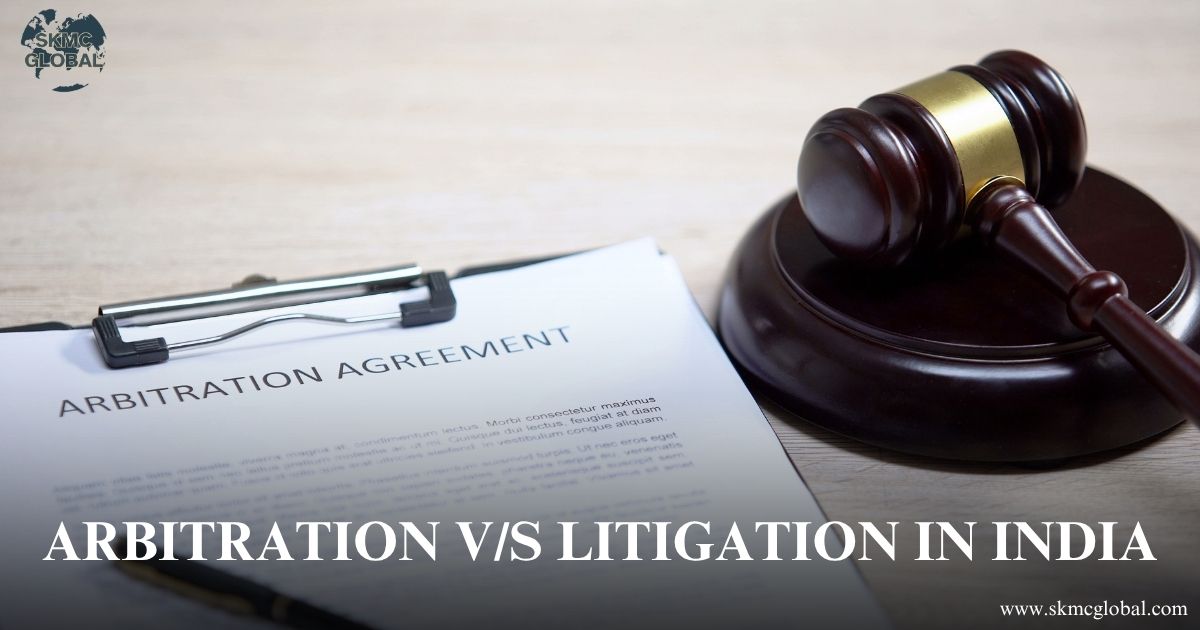
With business growing and transactions becoming more complex, differences will always arise. Whether a dispute relating to a contract, payment or performance level terms, having the appropriate solution mechanism for the same may be a matter of keeping time, money, and relationships in place.
Conflicts in India are typically resolved through arbitration or litigation. But arbitration or litigation - more relevant to your business? This article delves into the legal background, advantages, and strategic aspects of both processes, with specific reference to arbitration in India and cross-border business dealings.
Litigation and Arbitration in India
Indian Litigation
Indian litigation is court resolution of disputes governed by:
- Code of Civil Procedure, 1908 (CPC)
- The Indian Evidence Act, 1872
- The Constitution of India (especially for writ and public interest litigation)
It is a formal procedure whereby the parties place their cases before the judge in an open court. Orders passed are enforceable, appealable.
Arbitration in India
Indian arbitration is an autonomous process of resolving disputes under the Arbitration and Conciliation Act, 1996, based on international models like the UNCITRAL Model Law and the New York Convention, and under which international arbitration is enforceable all over the world.
In international commercial arbitration, parties submit a dispute voluntarily to a third-party neutral arbitrator who issues an enforceable binding order (award). Arbitration is private, quicker, and more adaptable in procedure.
Important Features of Arbitration in India
1.Time-Efficiency
An award shall be issued under Section 29A of the Indian Arbitration Act within 12 months of the date of appointment of the tribunal, which can be extended to 18 months with permission. This keeps the process in sync with litigations before courts.
2.Party Autonomy
The autonomy that arbitration allows is most likely the most advantageous feature of it in resolving disputes—the parties can choose arbitrators, decide location, language, rules of procedure, and even the applicable law.
3. Confidentiality
Confidentiality pursuant to Section 42A is assured except to the extent disclosure is required for enforcement purposes. This is a further benefit where proceedings involve trade secrets or in-house business affairs.
4. Cross-Border Enforcement
Due to India's accession to the New York Convention, commercial international arbitration awards can be enforced in more than 160 nations—facilitating confidence between parties in cross-border dealings.
5.Facilitative Judiciary
Indian courts are increasingly ready to refer cases to arbitration such that intervention is limited to the bare essentials in cases such as interim relief (Section 9), selection of arbitrators (Section 11), or setting aside awards (Section 34).
Problems of Arbitration in India
Even though Indian arbitration is employed due to its speed and flexibility, Indian arbitration has its own drawbacks:
- Cost: Fee of arbitrators, venue, and administrative fees can be significant—particularly in commercial international arbitration where sums are high or foreign specialists are employed.
- Delayed enforcement: Despite the fact that awards are decree-enforceable, their enforcement could be delayed if they are challenged under Section 34.
- Interim Relief: Although arbitrators can grant interim relief (Section 17), enforcement still usually requires the assistance of the courts.
Therefore, litigation and arbitration can complement each other instead of conflicting.
When to Litigate?
Notwithstanding its deficiencies, litigation must be used in the following situations:
- Statutory and criminal proceedings (e.g., insolvency, tax, fraud)
- Public interest or government contracts in which arbitration might not be permissible
- Where there is urgency for interim relief and the arbitrators have not been appointed
- Where appeal rights are necessary, e.g., policy or constitutional issues
- Where there are such issues, arbitration vs litigation tilts in favor of the latter because of enforceability and wider jurisdiction of the courts.
When to opt for Arbitration?
Arbitration is best when:
- The dispute is solely commercial
- Confidentiality is a significant issue
- Adjudication is wished to be timely and binding
- An international cross-border element necessitates international arbitration enforceability
- The parties want adjudicators who are experts in the industry (e.g., engineers in a building case)
Here, the arbitral flexibility to solve conflicts is a great business advantage.
Hybrid Approach: A Combination of Both
New commercial contracts typically employ a tiered clause, which includes:
1. Negotiation
2. Mediation or conciliation
3. Arbitration
This type of mechanism is categorized under arbitration conciliation and other forms of dispute resolution, which allows for conflicts to be resolved at the lowest level of adversarial and cost first. Elsewhere, arbitration is the back up.
Sample clause
"Any differences which may arise as a result of this agreement will first be tried to be settled by negotiations between the parties. In case of failure, the difference will be taken to arbitration according to the Arbitration and Conciliation Act, 1996. The seat would be at Mumbai and the proceedings would be in English."
Conditions of this type minimize risk of litigation and provide certainty regarding arbitration for resolution of dispute.
Arbitration in India and International Arbitration
The distinction between Indian arbitration and international arbitration is mostly domicile of parties and seat of arbitration. International arbitration is when the seat of arbitration or a party is somewhere else other than India.
Foreign awards are enforced and accepted in India by:
- The New York Convention (Section 44–52)
- The Geneva Convention (although rarely used these days)
This international architecture is precisely what gives commercial international arbitration a certain mechanism in multinational treaties.
Recent Reforms Unifying Arbitration Law in India
1. 2015 Amendment: Enshrined timelines and interim relief by arbitrators (Section 17)
2. 2019 Amendment: Set up Arbitration Council of India, encouraged institutional arbitration
3. Judicial Support: Supreme Court rulings like Vidya Drolia v. Durga Trading Corp codify policy of minimal court intervention
These reforms have served to solidify faith in India's arbitration law, particularly in commercial international arbitration.
Conclusion
Each commercial contract must make a conscious choice of the suitable method of resolution of disputes based on:
- Size and nature of contract
- Priority location of parties
- Need for speed, confidentiality, and neutrality
- Ease and cost of enforcement
- Statutory and regulatory restraints
Although arbitration in India is more appealing than ever, litigation continues to be present in enforcement and statutory remedy.
Companies should go beyond typical boilerplate wording and seek the advice of legal professionals to create custom models of conflict resolution. This reduces risk, insulates relationships, and provides a less complicated point of exit if there is disagreement.
Recent Posts
-
 Secretarial Audit for Unlisted and Private Compani...
Dec 19,2025
Secretarial Audit for Unlisted and Private Compani...
Dec 19,2025
-
 How to Get CTE and CTO under Environmental Laws in...
Nov 27,2025
How to Get CTE and CTO under Environmental Laws in...
Nov 27,2025
-
 Step by Step guide for appointment of Independent ...
Nov 06,2025
Step by Step guide for appointment of Independent ...
Nov 06,2025
-
 Liaison Office vs Branch Office: A comparative ana...
Sep 02,2025
Liaison Office vs Branch Office: A comparative ana...
Sep 02,2025
-
 Role of Shareholders Agreement in Startups and Inv...
Aug 30,2025
Role of Shareholders Agreement in Startups and Inv...
Aug 30,2025
-
 Setting Up a Wholly Owned Subsidiary (WOS) in Indi...
Aug 12,2025
Setting Up a Wholly Owned Subsidiary (WOS) in Indi...
Aug 12,2025
-
 Arbitration v/s Litigation in India...
Aug 05,2025
Arbitration v/s Litigation in India...
Aug 05,2025
-
 Declaration of Dividend under Companies Act, 2013...
Aug 02,2025
Declaration of Dividend under Companies Act, 2013...
Aug 02,2025
-
 What is MSME Form 1 and how it can be filed?...
Aug 01,2025
What is MSME Form 1 and how it can be filed?...
Aug 01,2025
-
 What is CSR and how to compute the contribution am...
Jul 31,2025
What is CSR and how to compute the contribution am...
Jul 31,2025
-
 Process for removal of company auditor under Compa...
Jul 31,2025
Process for removal of company auditor under Compa...
Jul 31,2025
-
 What is SBO Compliance and when it is needed?...
Jul 29,2025
What is SBO Compliance and when it is needed?...
Jul 29,2025
-
 Role of Key Management Personnel and their appoint...
Jul 28,2025
Role of Key Management Personnel and their appoint...
Jul 28,2025
-
 Registering a Partnership Firm in India...
Jul 28,2025
Registering a Partnership Firm in India...
Jul 28,2025
-
 Procedure to strike off a company...
Jul 28,2025
Procedure to strike off a company...
Jul 28,2025
-
 sox and internal control...
Jul 17,2025
sox and internal control...
Jul 17,2025
-
 ICFR Applicability as per the Companies Act, 2013...
Jul 15,2025
ICFR Applicability as per the Companies Act, 2013...
Jul 15,2025
-
 Concept of Sweat Equity Shares and its uses...
Jun 25,2025
Concept of Sweat Equity Shares and its uses...
Jun 25,2025
-
 Whether loans and borrowing are considered as depo...
Jun 18,2025
Whether loans and borrowing are considered as depo...
Jun 18,2025
-
 What are the major compliance for unlisted compani...
Jun 05,2025
What are the major compliance for unlisted compani...
Jun 05,2025
-
 A Guide to Compensation to Director in Indian Corp...
Jun 04,2025
A Guide to Compensation to Director in Indian Corp...
Jun 04,2025
-
 Loans to Company Directors- A Legal and Ethical Fr...
Jun 04,2025
Loans to Company Directors- A Legal and Ethical Fr...
Jun 04,2025
-
 Top 7 Things You Must Know About External Commerci...
May 16,2025
Top 7 Things You Must Know About External Commerci...
May 16,2025
-
 Integrating CSR into Your Business Model:A Step-by...
May 14,2025
Integrating CSR into Your Business Model:A Step-by...
May 14,2025
-
 What are the applicable Labour Laws in HR (Human R...
May 14,2025
What are the applicable Labour Laws in HR (Human R...
May 14,2025
-
 Unveiling the PRAVAAH Portal: A Comprehensive Guid...
Apr 18,2025
Unveiling the PRAVAAH Portal: A Comprehensive Guid...
Apr 18,2025
-
 FLA Return and its compliance...
Feb 08,2022
FLA Return and its compliance...
Feb 08,2022
-
 Process of closure of Branch office in India...
Dec 30,2021
Process of closure of Branch office in India...
Dec 30,2021
-
 Steps to Shut down the Liaison Office in India...
Sep 14,2021
Steps to Shut down the Liaison Office in India...
Sep 14,2021
-
 Procedure for closure of Project Office in India...
Aug 10,2021
Procedure for closure of Project Office in India...
Aug 10,2021
